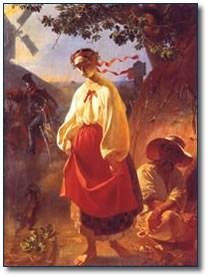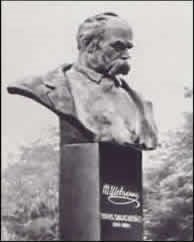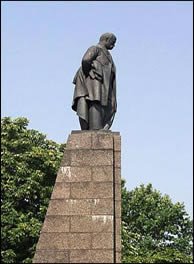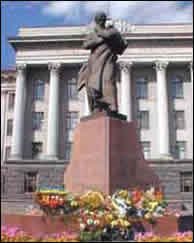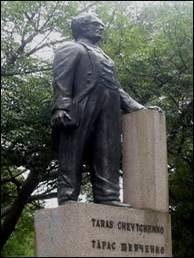Taras Hryhorovich Shevchenko (виховний захід на обласному семінарі)
Taras Hryhorovich Shevchenko, the great Ukrainian poet, artist and thinker, was born on March 9,
His grandfather I. Shevchenko, who was a witness of the Haidamak movement, had a significant influence on
Taras Hryhorovich Shevchenko, the great Ukrainian poet, artist and thinker, was born on March 9, 1814, in the village of Moryntsi in central Ukraine, then part of the Russian Empire. His parents, H. Shevchenko and K. Shevchenko, were serfs on the land of V. Engelhardt.
His grandfather I. Shevchenko, who was a witness of the Haidamak movement, had a significant influence on Taras. Taras's father was literate, and he sent his son to be educated as an apprentice to a deacon. In 1823, Taras's mother died, and his father married for a second time. In 1825, his father also died. For some time little Taras, now an orphan, served as a houseboy and was in training as a servant. A talent for drawing showed itself in the boy quite early. When he was 14 years old, he became a domestic servant to P. Engelhardt.
In the spring of 1829, Taras travelled with P. Engelhardt to Vilnius, Lithuania. There he studied painting under an experienced craftsman. The Polish rebellion for national liberation from Russia began in November, 1830, and Engelhardt left for the Russian capital, St. Petersburg. Shevchenko stayed with the lord's servants in Vilnius and was witness to the revolutionary events. Shevchenko went to St. Petersburg at the beginning of 1831. In 1832, the lord "contracted" him to the master painter V. Shyryayev, with whom the lad experienced a hard school of professional training
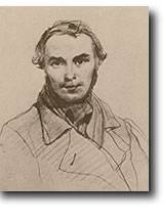 Noted writers and artists bought Shevchenko out of serfdom. The 2,500 rubles required were raised through a lottery in which the prize was a portrait of the poet, Zhukovsky, painted by Karl Bryullov. The release from serfdom was signed on April 22, 1838. A committee of the Association for the Encouragement of Artists had examined drawings by Shevchenko and approved them. In 1838, Shevchenko was accepted into the Academy of Arts as an external student, practicing in the workshop of K. Bryullov.
Noted writers and artists bought Shevchenko out of serfdom. The 2,500 rubles required were raised through a lottery in which the prize was a portrait of the poet, Zhukovsky, painted by Karl Bryullov. The release from serfdom was signed on April 22, 1838. A committee of the Association for the Encouragement of Artists had examined drawings by Shevchenko and approved them. In 1838, Shevchenko was accepted into the Academy of Arts as an external student, practicing in the workshop of K. Bryullov.
Fate
You did not play me false, 0 Fate,
You were a brother, closest friend
To this poor wretch. You took my hand
When I was still a little tot
And walked me to the deacon's school
To gather knowledge from the sot.
"My boy, just study hard," you said,
And you'll be somebody in time!"
I listened, studied, forged ahead,
Got educated. But you lied.
What am I now? But never mind!
We've walked the straight path, you and I,
We have not cheated, compromised
Or lived the very slightest lie.
So let's march on, dear fate of mine!
My humble, truthful, faithful friend!
Keep marching on: there glory lies;
March forward - that's my testament.
Taras Shevchenko
Nizhny Novgorod, February 9th, 1858.
Translated by John Weir, Toronto
In January, 1839, Shevchenko was accepted as a resident student at the Association for the Encouragement of Artists, and at the annual examinations at the Academy of Arts, Shevchenko was given the Silver Medal for a landscape. In 1840 he was again given the Silver Medal, this time for his first oil painting, The Beggar Boy Giving Bread to a Dog.
Shevchenko began to write poetry even before he was freed from serfdom. In 1840, the world first saw the Kobzar, Shevchenko's first collection of poetry. Later Ivan Franko wrote that this book, "immediately revealed, as it were, a new world of poetry. It burst forth like a spring of clear, cold water, and sparkled with a clarity, breadth and elegance of artistic expression not previously known in Ukrainian writing." In 1841, the epic poem Haidamaky appeared as a separate volume. In September of that same year, Shevchenko got his third Silver Medal -- for his picture The Gypsy Fortune Teller. A significant work is the painting Kateryna, based on his poem.
The Days Go By
|
The days go by, the nights go by, |
Taras Shevchenko
Vyunishcha, December 21, 1845
Translated by John Weir
In the spring of 1846, the poet lived for some time in Kiev, where he met the members of the Kyrylo-Methodius Society. The views of the poet had a great influence on the program of this secret society and on the philosophical outlook of many of his contemporaries. In 1847, arrests began of the members of the Kyrylo-Methodius Society and Shevchenko was arrested on April 5, on a ferry crossing the Dnipro River near Kiev. The next day, the poet was sent to St. Petersburg. He arrived there on April 17, 1847, and was imprisoned. Here he wrote the cycle of poems In the Dungeon. Of all the members of the association who came under investigation, Shevchenko was punished most severely. On June 8, 1847, Shevchenko was established at distant Orenburg, and later he was sent to the fort at even more distant Orsk. From the very first days, Shevchenko violated the tsar's order. He transcribed the prison cycle into a small secret book he kept in his boot, and he wrote new poems into the book.
|
The lights are blazing, music's playing, |
Taras Shevchenko
Orenburg, 1850
Translated by John Weir, Toronto
While awaiting permission to return, Shevchenko began a diary, an important documentation of his views. On August 2, 1857, having received permission to travel to St. Petersburg, Shevchenko left the fort at Novopetrovsk. In Nizhniy Novgorod, he learned that he was forbidden to go to Moscow or St. Petersburg, on pain of being returned to Orenburg.
Song - «A Spring Evening» («Садок вишневий біля хати».)
In May, 1859, Shevchenko got permission to go to Ukraine. He intended to buy a plot of land not far from the village of Pekariv, to build a house there, and to settle in Ukraine. In July he was arrested on a charge of blasphemy, but was released and ordered to go to St. Petersburg without fail. The poet arrived there on September 7, 1859. Nevertheless, to the end of his life, the poet hoped to settle in Ukraine.
I Am Unwell
|
I am not feeling well, I fear, |
Taras Shevchenko
St. Petersburg, November 22nd, 1858.
Translated by John Weir, Toronto
The poet began to feel increasingly ill, and complained in letters about the state of his health. Taras Shevchenko died in his studio apartment St. Petersburg at 5:30 a.m. on March 10, 1861. At the Academy of Arts, over the coffin of Shevchenko, speeches were delivered in Ukrainian, Russian and Polish. The poet was first buried at the Smolensk Cemetery in St. Petersburg. Then Shevchenko's friends immediately undertook to fulfil the poet's Zapovit (Testament), and bury him in Ukraine. The coffin with the body of Shevchenko was taken by train to Moscow, and then by horse-drawn wagon to Ukraine. Shevchenko's remains entered Kiev on the evening of May 6, and the next day they were transferred to the steamship Kremenchuh. On May 8 the steamship reached Kaniv, and Taras was buried on Chernecha Hill (now Taras Hill) by the Dnipro River. A tall mound was erected over his grave, and it has become a sacred site for the Ukrainian people.
Song – «The Mighty Dnieper» ( «Реве та стогне Дніпр широкий».)
Calamity Again
Dear God, calamity again! ...
It was so peaceful, so serene;
We but began to break the chains
That bind our folk in slavery ...
When halt! ... Again the people's blood
Is streaming! Like rapacious dogs
About a bone, the royal thugs
Are at each other's throat again.
Taras Shevchenko
Novopetrovsk Fortress, 1854 (?)
Translated by John Weir, Toronto
Taras H. Shevchenko Museum.

The Taras H. Shevchenko Museum, owned and operated by the Taras H. Shevchenko Museum and Memorial Park Foundation, is a non-profit corporation, founded by the Association of United Ukrainian Canadians, for the purpose of popularizing the life and work of the Bard of Ukraine, and the contribution of Canadians of Ukrainian descent to the social, economic and political life of Canada. See our Mission Statement.
The Museum is located in Toronto and is the second such institution operated by the Foundation. The original Museum, opened to celebrate Canada Day, 1952, was located in a 16 acre park near Oakville, Ontario. It complemented a monument to Taras Shevchenko, the first in the Americas, which was unveiled the previous year, on the 60th anniversary of Ukrainian immigration to this country. The monument and much of the original collection of exhibits were gifts of the people of Ukraine to their kinfolk in Canada. Unfortunately, the original Museum, including its valuable collections, was destroyed by arson in September 1988, and in December 2006, the 3-metre bronze Shevchenko statue was stolen.
Today's Museum, unique in the Western world, is similar in size to the original, but has amassed collections far superior in size, quality and variety, including extensive research materials. These efforts, and the ongoing cultural work of the Foundation are entirely financed by personal donations from our friends and supporters. The central focus of the Musem are exhibits dedicated to the art, life and literary legacy of the founder of the modern Ukrainian language. On display are many editions of his Kobzar (poetry), just some of the over 100 in the Museum's collection. As well, the Museum has artistic copies of Shevchenko's creations in many genres, all of professional museum quality, specially commissioned in Ukraine for this Museum.Not all the exhibits available are on display at any one time, but are rotated on a regular basis to correspond with various themes from the life and work of the Bard of Ukraine. Shevchenko has twice been celebrated as a cultural leader of world acclaim by UNESCO.

Look at the myltimediablackboard, here you can see his works.
На мультимедійному проекторі присутні переглядають роботи Шевченка, що представлені в музеї.
Self-Portrait, 1840
Chihiryn viewed from the Subotiv Road, 1845
A peasant family, 1843
Portrait of Mayevska, 1843
Maria, 1840
Cathedral on the Ascension in Pereyaslav

Portrait of F.Tolstoy,
Etching, 1860

Self-Portrait with a Candle, 1860

Portrait of M.Shchepkin, 1858
Don't Wed
Don't wed a wealthy woman, friend,
She'll drive you from the house.
Don't wed a poor one either, friend,
Dull care will be your spouse.
Get hitched to carefree Cossack life
And share a Cossack fate:
If it be rags, let it be rags --
What comes, that's what you take.
Then you'll have nobody to nag
Or try to cheer you up,
To fuss and fret and question you
What ails you and what's up.
When two misfortune share, they say,
It's easier to weep.
Not so: it's easier to cry
When no-one's there to see.
Taras Shevchenko
Mirhorod, October 4th, 1845.
Translated by John Weir, Toronto
Don't Envy
Don't envy, friend, a wealthy man:
A rich man's life is spent
Without a friend or faithful love --
Those things he has to rent.
Don't envy, friend, a man of rank,
His power's based on force.
Don't envy, too, a famous man:
The man of note well knows
The crowd's acclaim is not for him,
But for that thorny fame
He wrought with labour and with tears
So they'd be entertained.
But then, when young folk gather 'round,
So fine they are and fair
You'd think it's heaven, -- ah, but look:
See evil stirring there ...
Don't envy anyone my friend,
For if you look you'll find
That there's no heaven on the earth,
No more than in the sky.
Monuments to Shevchenko
Monuments to Shevchenko are all over the world.People of all races, nationalities, beliefs and political views see the erection of monuments to Shevchenko as a demonstration of deep respect and love to a Ukrainian national genius, and as international recognition of his contribution to world culture. According to the former director of the Shevchenko National Museum in Kyiv, Serhiy Halchenko, there are now over 600 Shevchenko Monuments in the world.
Look at the myltimediablackboard.
На мультимедійному проекторі присутні переглядають пам’ятники Шевченку, які споруджені у різних країнах.
CANADA
Winnipeg, Canada
|
|
|
![]()
Winnipeg, Canada
|
|
|
![]()
Washington, USA
|
|
|
![]()
New York State, USA
|
|
|
![]()
Budapest, Hungary
|
|
This 3-metre bronze monument was unveiled on July 12, 2007. The project of the monument was developed by the professor of the Lviv Academy of Arts I. Mykytyuk. |
![]()
Rome, Italy
|
|
|
|
![]()
![]()
POLAND
Warsaw, Poland
|
|
|
![]()
Bilyi Bir, Poland
|
|
Sculptor: Vasyl Borodaj; |
![]()
ROMANIA
Buharest, Romania
|
|
|
![]()
![]()
Kyiv, Ukraine
|
|
The monument was erected according to the resolution of the Soviet Supreme Council of Comissars of Ukrainian SSR of April 10, 1935. The monument was erected in the Shevchenko Park across from the Shevchenko State University on March 6, 1939. The height of the statue is 6 metres, and the height of the entire monument is 14 metres. The base is made of pink granite. The statue was cast of bronze in the Leningrad's plant of the art casting. The text reads: "T. H. Shevchenko. 1814-1861" and below is part of his immortal Zapovit.
Sculptor: M. Manizer, Architect: E. Levinson; |
![]()
Kyiv, Ukraine
|
|
|
![]()
Kaniv, Cherkasy Province, Ukraine
|
|
Bronze, Granite;
The monument was unveiled in 1939; |
![]()
![]()
Lutsk, Ukraine
|
|
|
![]()
Luhansk, Ukraine
|
|
Sculptor: Ivan Chumak; |
Khodoriv, Lviv Province, Ukraine
|
|
|
![]()
Sofia, Bulgaria
|
|
The monument was inaugurated on Renascence Square in Sofia, Bulgaria in May 2009. |
St. Petersburg, Russia
|
|
|
![]()
St. Petersburg, Russia
|
|
Monument to Taras Shevchenko in St. Petersburg, Russia |
Moscow, Russia
|
|
Sculptors: Mykhaylo Hritsiuk, Yuri Sinkevich, Anatoly Fuzhenko, with help of Ivan Kavaleridze; Photo from: www.dorogomilovo.ru |
BELORUS
Minsk, Belorus
|
|
|
KAZAKHSTAN
Almaty, Kazakhstan
|
|
|
|||||||||||||||
|
ARGENTINA
BRAZIL
Curitiba, Brazil
Tiraspol, Moldova
Tashkent, Uzbekistan
|
||||||||||||||||
|
|
|
|
Звучить «Tastement» ( Заповіт).


про публікацію авторської розробки
Додати розробку

